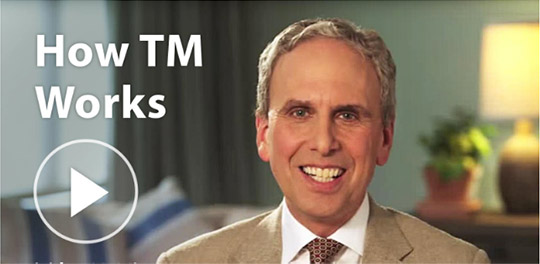Transcendental Meditation® (TM®) is a simple, natural, effortless technique, practiced for 15-20 minutes morning and evening, while sitting comfortably with eyes closed. It allows the mind and body to gain a deep state of rest, in some ways deeper than sleep, thereby dissolving deeply rooted stresses. It simultaneously produces increased orderliness of brain functioning.
Over 390 published, peer-reviewed research studies document its effectiveness in improving stress-related conditions such as anxiety, heart disease, insomnia, PTSD, and more.

Five Things You Should Know
What TM is
The TM technique is taught by certified professionals in a standardized seven-step course. Instructions are always given in personal, one-on-one lessons with a teacher. It cannot be learned from a book, electronic device, etc.
What TM isn’t
TM is not a philosophy, way of life, or religion, and is practiced by people of all walks of life, ages, nationalities, and religious or secular affiliations.
How it works
The technique makes it easy to experience increasingly quieter levels of the thinking process and settle down to a unique state of restful alertness, a quiet state that exists within all of us. This process of transcendence is spontaneously accompanied by very deep rest and increased brain orderliness that results in:
- release of stress
- greater energy
- clearer thinking
- better health
- overall positivity
- many other reported benefits
For this, the student is given a meaningless sound, or mantra, and is taught how to use it to effortlessly gain access to his or her own silent self.
How it is different
TM is not a technique of concentration, contemplation, or mind control. It’s an effortless process that utilizes the natural tendency of the mind to gravitate towards its own inner silence. TM sets up the ideal conditions for the natural process of transcendence to take place.
What the benefits are
Research on TM includes these benefits to the mind, body, and behavior:
- greater clarity of mind
- increased creativity and problem solving
- increased neurological efficiency
- reduced symptoms of PTSD
- healthier heart performance
- relief from anxiety and depression
- healthier relationships
- reduced substance abuse
- improved emotional stability
- reduced violent behavior and crime
Common Questions
[expand title="What if I can’t sit still long enough to meditate?"]The experience of restful alertness is pleasant and comfortable and quickly dissolves stress.
As you become less nervous and anxious, sitting to meditate becomes an even more refreshing experience. Even a ten-year-old child can practice the Transcendental Meditation technique.[/expand]
[expand title="Were these studies done only by scientists who meditate?"]More than 390 peer-reviewed research studies on the TM technique have been published since 1970. The research has been conducted in 33 countries and at more than 250 independent universities and institutions, including Harvard Medical School, Yale Medical School, UCLA Medical School, Stanford Medical School, University of Virginia Medical School, and many others.
Many of these studies were done by scientists who have no affiliation with the TM organization.[/expand]
[expand title="What about people who say, “A run in the woods is my TM,” or, “A good fishing trip will do the same thing for you”?"]A hike or run through the forest, relaxing with a good book at the beach—these are pleasant, restorative activities because they allow the mind to step out of the constraints of its habitual, narrow boundaries of focused attention.
But it’s rest that most powerfully rejuvenates—not more activity. If we want to do and enjoy more, we must rest more deeply, more efficiently, more completely.
The TM technique is an effortless, natural process that allows the mind and body to experience very deep rest. Having that experience every day does much more for our health and well-being than a walk in the woods or a great fishing trip.[/expand]
[expand title="What’s the difference between TM and other forms of meditation? Can the same benefits be obtained by any other methods?"]Comparative research has shown that the various forms of meditation do not produce the same effects. Because each kind of meditation engages the mind in its own way, there’s no reason to expect the same results from the various methods, or that scientific research on Transcendental Meditation will apply to other practices.
- Neural imaging and EEG studies indicate that TM practice creates a unique brain pattern.
- TM is the only meditation technique known to create widespread brainwave coherence.
- The American Heart Association says that TM is the only form of meditation that can be recommended for reducing blood pressure.
- TM is more effective at reducing anxiety and depression.
[/expand]
[expand title="Can you get the same results simply by relaxing?"]Not according to the science. A wide range of beneficial physiological changes commonly occur during TM, changes that distinguish the practice from mere relaxation and other forms of meditation.
- A state of rest much deeper than sitting with eyes-closed and also much deeper than other meditation practices
- A natural decrease in breath rate during TM, 25% greater than controls, and an increase in basal skin resistance (a standard measure of relaxation) up to 70% higher
- Marked changes in breathing, blood lactate, and heart rate
- Regulated cortisol and other hormones associated with chronic stress
- Healthier regulation of serotonin, a neurotransmitter associated with mood
- Increased integration and orderliness of brain functioning—further differentiating the Transcendental Meditation technique from ordinary relaxation and other meditation practices
[/expand]
